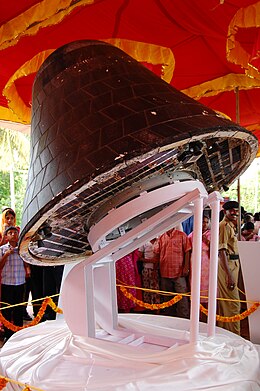SRE-1

The SRE-1 spacecraft on public display at Thiruvananthapuram in April 2007
|
|
| Mission type | Technology |
|---|---|
| Operator | ISRO |
| COSPAR ID | 2007-001C |
| SATCAT no. | 29711 |
| Mission duration | 12 days |
| Spacecraft properties | |
| Manufacturer | ISRO |
| Launch mass | 550 kilograms (1,210 lb) |
| Start of mission | |
| Launch date | 10 January 2007, 03:54 UTC |
| Rocket | PSLV C7 |
| Launch site | Satish Dhawan FLP |
| Contractor | ISRO |
| End of mission | |
| Landing date | 22 January 2007, 04:16 UTC |
| Landing site | Bay of Bengal |
| Orbital parameters | |
| Reference system | Geocentric |
| Regime | Low Earth |
The Space Capsule Recovery Experiment (SCRE or more commonly SRE or SRE-1) is an Indian experimental spacecraft which was launched at 03:53 UTC on January 10, 2007 from Sriharikota by the Indian Space Research Organisation (ISRO). The launch was conducted using the PSLV C7 rocket, along with three other satellites. It remained in orbit for 12 days before re-entering the Earth's atmosphere and splashing down into the Bay of Bengal at 04:16 UTC on January 22.
SRE-1 was designed to demonstrate the capability to recover an orbiting space capsule, and the technology of an orbiting platform for performing experiments in microgravity conditions. It was also intended to test reusable Thermal Protection System, navigation, guidance and control, hypersonic aero-thermodynamics, management of communication blackout, deceleration and flotation system and recovery operations.
SRE-1 is a 555 kg capsule. It comprises aero-thermo structure, internal structure, Mission Management Unit, Altitude sensors and Inertial measurement unit, S-band transponder with unique belt array antenna embedded to ATS, power and electronics packages to support deceleration and flotation system. It also houses two microgravity payloads. It has a sphere-cone-flare configuration with a spherical nose of about 0.5 m radius, base diameter of 2 m and 1.6 m height. The parachute, pyro devices, avionics packages of triggering unit and sequencer, telemetry and tracking system and sensors for measurement of system performance parameters are placed inside the SRE-1 capsule. Parachutes for SRE capsule were provided by ADRDE.
To withstand the heat of re-entry, the cone-shaped SRE-1 has a heat shield composed of silica tiles over much of the surface, and an ablative nose cap of carbon-phenolic composite. ISRO is also working on technology to manufacture carbon-carbon composite heat shields, which, along with the silica tiles tested with the SRE-1, could find use in future reusable spacecraft such as ISRO's planned Reusable Launch Vehicle.
...
Wikipedia
